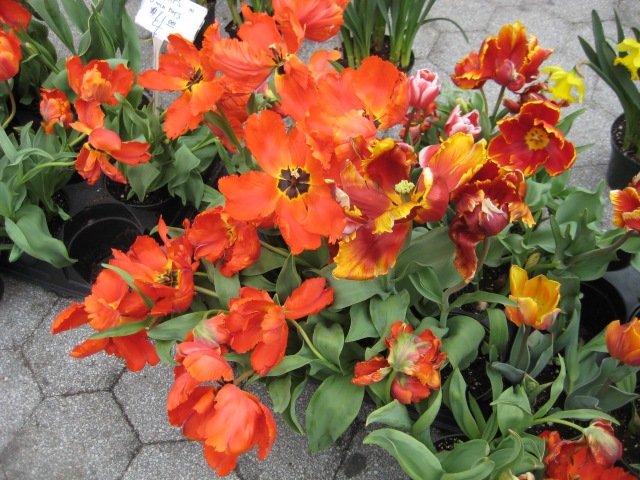This is the most bustling, enticing, delicious farmer’s market I’ve ever been to. Local spring greens, potatoes, herbs, leeks. Muffins, honey, goat cheese, maple syrup. And flowers, flowers, flowers, flowers. The famous Greenmarket in Union Square. Funny, I had to go to New York City to find flowers blooming.
It was a refined form of torture for me to have to walk past dozens of stalls selling plants of every description, and not be able to buy any. But the daffodils and the pansies wouldn’t survive being stuffed in a backpack and carted around the city. And it’s not like there aren’t a few plant stores where I live, upstate. But still…
So I had to settle for virtual images instead of the real thing.  A clump of parrot tulips in a corner caught my eye–rather bedraggled, but I have a thing for parrot tulips and their huge feathery-edged petals. My grandfather used to grow them in his garden.
A clump of parrot tulips in a corner caught my eye–rather bedraggled, but I have a thing for parrot tulips and their huge feathery-edged petals. My grandfather used to grow them in his garden.
And when I got up close to them and looked them right in the eye, so to speak, I understood why the old Dutch artists were so enthralled by images of parrot tulips. They’re the Marilyn Monroes of the plant world–no matter how dishevelled or windblown, you just can’t take a bad picture of them.
The thing that really hits you in the eye is the bull’s-eye in the center–the velvet black surrounded by lemon yellow in the center of the red. You’d think it would be perfect for luring in pollinators, but actually it’s false advertising. Tulips don’t bother much with sex anymore.
You’d think it would be perfect for luring in pollinators, but actually it’s false advertising. Tulips don’t bother much with sex anymore.
Tulips don’t need insect pollinators. Lovingly tended by their willing human servants, tulips rarely create viable seeds–the ability to sexually reproduce has been all but bred out of them by generations of horticulturists who want every flower they sell to be an exact duplicate of the parent. After all, horticulturists are creating a piece of merchandise that must turn out exactly the way it’s represented in the garden catalog.  So you don’t buy tulip seed. You buy tulip clones, in the shape of bulbs that have cloned off another bulb, which cloned off another bulb, and so on back into the plant’s history, all the bulbs having exactly the same genetic information. Tulips started out as wildflowers, but have been shaped and cultivated by humans since the Middle Ages or before.
So you don’t buy tulip seed. You buy tulip clones, in the shape of bulbs that have cloned off another bulb, which cloned off another bulb, and so on back into the plant’s history, all the bulbs having exactly the same genetic information. Tulips started out as wildflowers, but have been shaped and cultivated by humans since the Middle Ages or before.
In ancient Persia, it was a tradition that giving red tulips was an expression of love–the black in the center represents the lover’s heart burned to a coal by fiery passion.







Wow! I learned something new with every sentence.
I just love tulips. I never succeed in growing them myself, mind you, but they’re fun to watch when others do!